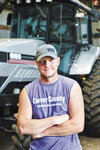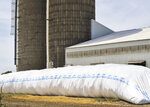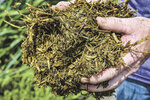


Describe your farm and facilities. We have a double-4 step-up parlor. Our farm is run by me and my wife, Michelle; our three kids, Jacob, Libby and Zander; my parents, Leonard and Rose Hoen; and a hired hand.
What forages do you harvest? We harvest haylage, corn silage and oatlage.
How many acres of crops do you raise? We have about 600 acres of cropland — about 55 acres of alfalfa, 30-35 acres of silage corn, 10 acres of oats, and the rest is planted to soybeans or grain corn.
Describe the rations for your livestock. We have a total mixed ration and do about 50-50 corn silage and haylage. We add a custom blend from the local feed mill and an on-farm blend that includes corn, cottonseed, soybean meal, extruded meal, whole soybeans and fat. We also have oatlage that I will feed as a filler with either third- or fourth-crop haylage. It seems to work well.
What quality and quantity do you harvest of each crop? We try to cut our alfalfa at 28 days for each crop. Sometimes it differs, depending on the weather we are having during that time. We watch the fields for buds, and by the time I am cutting, about half the field is at budding stage. We try to harvest our haylage at 60% moisture since we have a dryer silage. For our silage, we chop it at about 58% moisture. Since it is going in a silo, we don’t want it to be too wet.
Describe your harvesting techniques for alfalfa and corn silage. All of the alfalfa gets cut with a disk mower, and the following day it will get chopped. I start out by laying the rows at 13-feet wide and slowly lay them tighter as I am cutting to help hold some of the moisture in. I try to emphasis the moisture because it helps so much in the TMR mixer and the feed bunk. We harvest our haylage with a New Holland 230 pull-type chopper, and we usually use three chopper boxes. Everything will get cut at a 3/4-inch length. The silage will also go through a processor that we added about 15 years ago. We were able to finish our first-crop haylage on May 30.
What techniques do you use to store, manage and feed your forages. All of our haylage and oatlage goes in a bag. We end up filling four 9- by 250-foot bags. We lay our bags north and south, which lets us open the bags on the north side during the summer to limit sun exposure. I try to only have one bag open at a time, especially during the summertime, while managing the length of it so that the wind doesn’t get underneath it, and I will have tires with strings on them to hold the seams down to prevent air from getting underneath. Our silage goes into two 18- by 65-foot silos, which can hold around 300 to 320 tons each.
How does quality forages play in the production goals for your herd? Milk production is probably our biggest goal. Having quality forages is definitely one of our top three goals. We have noticed a difference as we have been making changes to our forages.
What are management or harvesting techniques you have changed that has made a notable difference in forage quality? We added a kernel processor about 15 years ago and switched to a TMR about 18 years ago, which has certainly helped with labor and cow health. We stopped feeding dry hay in our rations and created a tighter cutting window within the last five years. This has made a difference across the board. It helps in the bunk with more moisture, so they don’t sort it. Milk production has gone up, and feed costs are more manageable. We have also noticed that it mixes faster since we don’t have to process the dry hay and mix it in. We also put on a granular inoculant at the bagger and the blower. I have found it helps to put extension hoses on the applicator so that the wind doesn’t blow the inoculant everywhere.
Describe a challenge you overcame in reaching your forage quality goals. Having a different cutting schedule and not baling any of it. We weren’t getting timely cuts. Now we have put more of an emphasis on it, and we can see the difference it is making.
Comments
No comments on this item Please log in to comment by clicking here